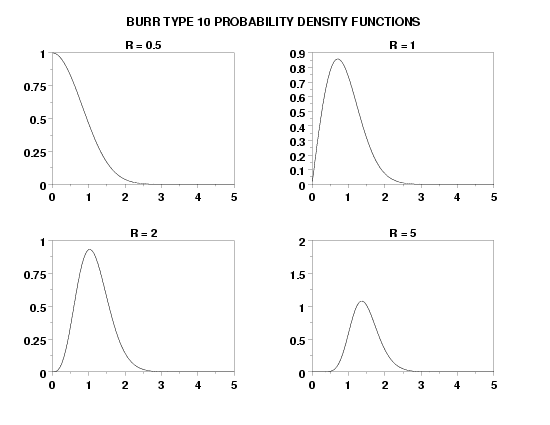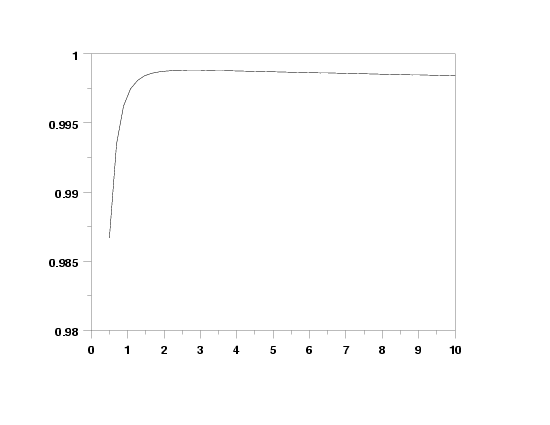

|
B10PDFName:

with r denoting the shape parameter. This distribution can be generalized with location and scale parameters in the usual way using the relation

If r = 1, the Burr type 10 distribution is equivalent to the Rayleigh distribution. For this reason, the Burr type 10 distribution is also referred to as the generalized Rayleigh distribution. It has found use in reliability applications.
<SUBSET/EXCEPT/FOR qualification> where <x> is a number, parameter, or variable; <y> is a variable or a parameter (depending on what <x> is) where the computed Burr type 10 pdf value is stored; <r> is a positive number, parameter, or variable that specifies the shape parameter; <loc> is a number, parameter, or variable that specifies the location parameter; <scale> is a positive number, parameter, or variable that specifies the scale parameter; and where the <SUBSET/EXCEPT/FOR qualification> is optional. If <loc> and <scale> are omitted, they default to 0 and 1, respectively.
LET Y = B10PDF(X,0.5,0,5) PLOT B10PDF(X,2,0,3) FOR X = 0 0.01 5
LET Y = BURR TYPE 10 RANDOM NUMBERS FOR I = 1 1 N BURR TYPE 10 PROBABILITY PLOT Y BURR TYPE 10 PROBABILITY PLOT Y2 X2 BURR TYPE 10 PROBABILITY PLOT Y3 XLOW XHIGH BURR TYPE 10 KOLMOGOROV SMIRNOV GOODNESS OF FIT Y BURR TYPE 10 CHI-SQUARE GOODNESS OF FIT Y2 X2 BURR TYPE 10 CHI-SQUARE GOODNESS OF FIT Y3 XLOW XHIGH The following commands can be used to estimate the r shape parameter for the Burr type 10 distribution:
LET R2 = <value> BURR TYPE 10 PPCC PLOT Y BURR TYPE 10 PPCC PLOT Y2 X2 BURR TYPE 10 PPCC PLOT Y3 XLOW XHIGH BURR TYPE 10 KS PLOT Y BURR TYPE 10 KS PLOT Y2 X2 BURR TYPE 10 KS PLOT Y3 XLOW XHIGH The default values for R1 and R2 are 0.5 and 10. The probability plot can then be used to estimate the location and scale (location = PPA0, scale = PPA1). The 2-parameter Burr type 10 maximum likelihood estimates can be obtained using the command
The maximum likelihood estimates are obtained as the solution of the following simultaneous equations (from Raqab and Kundu):
![(n/r) + SUM[i=1 to n][LN(1 - EXP(-(s*x(i))**2))] = 0](eqns/b10mle1.gif)
The BOOTSTRAP DISTRIBUTION command can be used to find uncertainty intervals for the parameter estimates based on the ppcc plot, the ks plot, and the maximum likelihood estimates.
Raqab and Kundu (2006), "Burr Type X Distributions: Revisited", Journal of Probability and Statistical Sciences, Vol. 4, No. 2, pp. 179-193. Johnson, Kotz, and Balakrishnan (1994), "Contiunuous Univariate Distributions--Volume 1", Second Edition, Wiley, pp. 53-54. Devroye (1986), "Non-Uniform Random Variate Generation", Springer-Verlang, pp. 476-477.
LABEL CASE ASIS
TITLE CASE ASIS
TITLE OFFSET 2
.
MULTIPLOT 2 2
MULTIPLOT CORNER COORDINATES 0 0 100 95
MULTIPLOT SCALE FACTOR 2
.
LET R = 0.5
TITLE R = ^r
PLOT B10PDF(X,R) FOR X = 0.01 0.01 5
.
LET R = 1
TITLE R = ^r
PLOT B10PDF(X,R) FOR X = 0.01 0.01 5
.
LET R = 2
TITLE R = ^r
PLOT B10PDF(X,R) FOR X = 0.01 0.01 5
.
LET R = 5
TITLE R = ^r
PLOT B10PDF(X,R) FOR X = 0.01 0.01 5
.
END OF MULTIPLOT
.
JUSTIFICATION CENTER
MOVE 50 97
TEXT Burr Type 10 Probability Density Functions

Program 2:
let r = 2.1
let rsav = r
.
let y = burr type 10 random numbers for i = 1 1 200
let y = 10*y
let amax = maximum y
.
burr type 10 ppcc plot y
let rtemp = shape - 2
let r1 = max(rtemp,0.05)
let r2 = shape + 2
y1label Correlation Coefficient
x1label R
burr type 10 ppcc plot y
let r = shape
justification center
move 50 6
text Rhat = ^r (R = ^rsav)
move 50 2
text Maximum PPCC = ^maxppcc
.
char x
line bl
burr type 10 prob plot y1
move 50 6
text Location = ^ppa0, Scale = ^ppa1
char bl
line so
.
relative hist y
limits freeze
pre-erase off
plot b10pdf(x,r,ppa0,ppa1) for x = 0.01 .01 amax
limits
pre-erase on
.
let ksloc = ppa0
let ksscale = ppa1
burr type 10 kolmogorov smirnov goodness of fit y
.
burr type 10 mle y
let ksloc = 0
let ksscale = scaleml
let r = rml
burr type 10 kolmogorov smirnov goodness of fit y

Date created: 11/27/2007 |